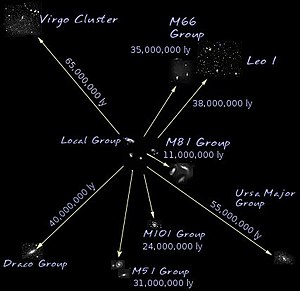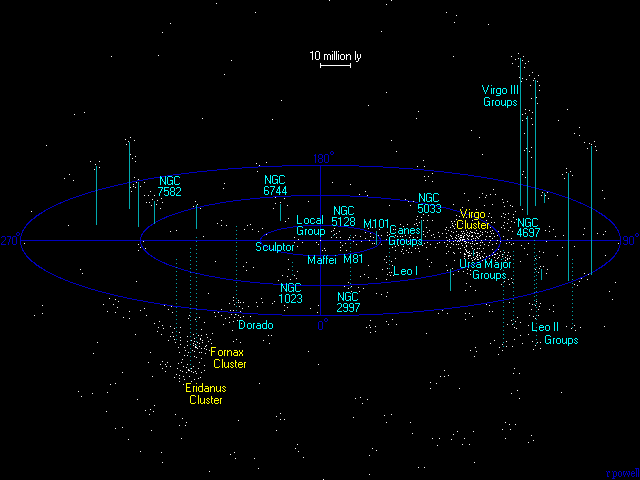Virgo Supercluster

The Virgo Supercluster (Virgo SC) or Local Supercluster is the large galaxy cluster that contains the Virgo Cluster and the Local Group.[1] At least 100 galaxies and clusters are in it.
The diameter of Virgo SC is 33 megaparsecs (110 million light-years). It is one of millions of superclusters in the observable universe.
Background
[change | change source]When the first large sample of nebulae was published by William and John Herschel in 1863, it was seen that there is a marked excess of nebular fields in the constellation Virgo (near the north galactic pole).
In the 1950s, it was suggested that this excess was a large-scale galaxy-like structure, a "Local Supercluster".[2][3] Debate went on during the 1960s and 1970s as to whether the Local Supercluster (LS) was actually a structure or a chance alignment of galaxies.[4] The issue was resolved with the large redshift surveys of the late 1970s and early 1980s, which showed a flattened concentration of galaxies along the supergalactic plane.[5]
Structure
[change | change source]In 1982 R. Brent Tully showed it consists of two components: a flattened disk with two-thirds of the supercluster's luminous galaxies, and a roughly spherical halo containing the remaining one-third.[6] The disk itself is a thin (~1 megaparsecs) ellipsoid with a long axis / short axis ratio of at least 6 to 1, and possibly as high as 9 to 1.[7]
Data released in June 2003 from a redshift survey lets astronomers compare the LS to other superclusters. The LS represents a typical poor (that is, it lacks a high density core) supercluster of rather small size. It has one rich galaxy cluster in the center, surrounded by filaments of galaxies and poor groups.[8]
The Local Group is on the outskirts of the LS in a small filament extending from the Fornax Cluster to the Virgo Cluster.[5] The Virgo Supercluster's volume is about 7000 times that of the Local Group or 100 billion times that of the Milky Way.

References
[change | change source]- ↑ The Local Group contains the Milky Way and Andromeda galaxies.
- ↑ cfa.harvard.edu, The geometry of the Local Supercluster, John P. Huchra, 2007 (accessed 12-12-2008)
- ↑ Shapley, Harlow 1959. Of stars and men.
- ↑ de Vaucouleurs G. (1981). "The Local Supercluster of Galaxies". Bulletin of the Astronomical Society of India. 9: 6 (see note). Bibcode:1981BASI....9....1D.
- ↑ 5.0 5.1 Klypin, Anatoly; et al. (2003). "Constrained simulations of the real universe: the Local Supercluster". The Astrophysical Journal. 596 (1): 19–33. arXiv:astro-ph/0107104. Bibcode:2003ApJ...596...19K. doi:10.1086/377574. S2CID 1830859.
- ↑ Hu F.X.; et al. (2006). "Orientation of galaxies in the Local Supercluster: a review". Astrophysics and Space Science. 302 (1–4): 43–59. arXiv:astro-ph/0508669. Bibcode:2006Ap&SS.302...43H. doi:10.1007/s10509-005-9006-7. S2CID 18837475.
- ↑ Tully R.B. (1982). "The Local Supercluster". Astrophysical Journal. 257 (1): 389–422. Bibcode:1982ApJ...257..389T. doi:10.1086/159999.
- ↑ Einasto M.; et al. (2007). "The richest superclusters. I. Morphology". Astronomy and Astrophysics. 476 (2): 697–711. arXiv:0706.1122. Bibcode:2007A&A...476..697E. doi:10.1051/0004-6361:20078037. S2CID 15004251.
